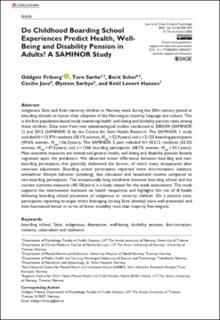| dc.contributor.author | Friborg, Oddgeir | |
| dc.contributor.author | Sørlie, Tore | |
| dc.contributor.author | Schei, Berit | |
| dc.contributor.author | Javo, Cecilie | |
| dc.contributor.author | Sørbye, Øystein | |
| dc.contributor.author | Hansen, Ketil Lenert | |
| dc.date.accessioned | 2021-01-04T10:23:19Z | |
| dc.date.available | 2021-01-04T10:23:19Z | |
| dc.date.created | 2020-10-15T14:04:28Z | |
| dc.date.issued | 2020 | |
| dc.identifier.citation | Journal of Cross-Cultural Psychology. 2020, 51 (10), 848-875. | en_US |
| dc.identifier.issn | 0022-0221 | |
| dc.identifier.uri | https://hdl.handle.net/11250/2721239 | |
| dc.description.abstract | Indigenous Sámi and Kven minority children in Norway were during the 20th century placed at boarding schools to hasten their adoption of the Norwegian majority language and culture. This is the first population-based study examining health, well-being and disability pension rates among these children. Data stem from two epidemiological studies conducted in 2003/04 (SAMINOR 1) and 2012 (SAMINOR 2) by the Centre for Sami Health Research. The SAMINOR 1 study included N=13,974 residents (50.1% women, Mage=52.9 years) and n=2,125 boarding participants (49.6% women, Mage=56.2 years). The SAMINOR 2 part included N=10,512 residents (55.5% women, Mage=47.6 years) and n=1246 boarding participants (48.7% women, Mage=54.1 years). Main outcome measures are mental and general health, well-being and disability pension linearly regressed upon the predictors. We observed minor differences between boarding and non-boarding participants that generally disfavored the former, of which many disappeared after covariate adjustment. Boarding school participants reported more discrimination, violence, unhealthier lifestyle behavior (smoking), less education and household income compared to non-boarding participants. The exceptionally long timeframe between boarding school and the current outcome measures (40-50 years) is a likely reason for the weak associations. The study supports the international literature on health inequalities and highlights the risk of ill health following boarding school placement of indigenous or minority children. On a positive note, participants reporting stronger ethnic belonging (strong Sámi identity) were well protected, and even functioned better in terms of lower disability rates than majority Norwegians. | en_US |
| dc.language.iso | eng | en_US |
| dc.publisher | Sage Journals | en_US |
| dc.relation.uri | https://journals.sagepub.com/doi/10.1177/0022022120962571 | |
| dc.rights | Navngivelse 4.0 Internasjonal | * |
| dc.rights.uri | http://creativecommons.org/licenses/by/4.0/deed.no | * |
| dc.title | Do Childhood Boarding School Experiences Predict Health, Well-Being and Disability Pension in Adults? A SAMINOR Study | en_US |
| dc.type | Peer reviewed | en_US |
| dc.type | Journal article | en_US |
| dc.description.version | publishedVersion | en_US |
| dc.source.pagenumber | 848-875 | en_US |
| dc.source.volume | 51 | en_US |
| dc.source.journal | Journal of Cross-Cultural Psychology | en_US |
| dc.source.issue | 10 | en_US |
| dc.identifier.doi | 10.1177/0022022120962571 | |
| dc.identifier.cristin | 1839849 | |
| dc.description.localcode | © The Author(s) 2020 Article reuse guidelines: sagepub.com/journals-permissions DOI: 10.1177/0022022120962571 journals.sagepub.com/home/jcc. This manuscript version is made available under the CC-BY 4.0 license. | en_US |
| cristin.ispublished | true | |
| cristin.fulltext | original | |
| cristin.qualitycode | 1 | |

